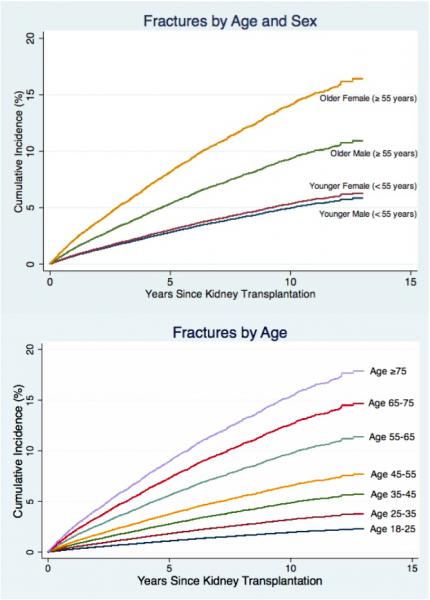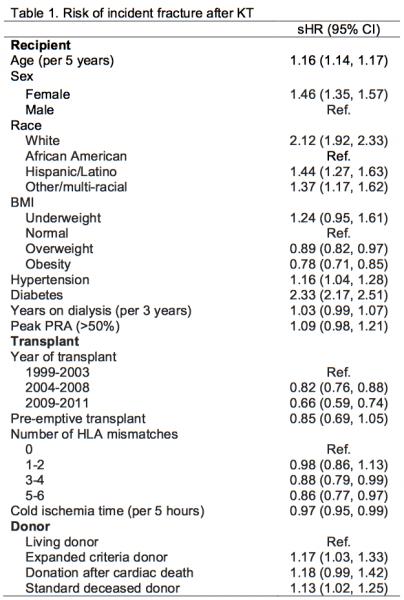The Incidence, Mortality and Prediction Model for Fractures After Kidney Transplantation in the United States.
JHU, Baltimore, MD
Meeting: 2017 American Transplant Congress
Abstract number: A210
Keywords: Kidney transplantation, Mortality, Prediction models
Session Information
Session Name: Poster Session A: Kidney Complications I
Session Type: Poster Session
Date: Saturday, April 29, 2017
Session Time: 5:30pm-7:30pm
 Presentation Time: 5:30pm-7:30pm
Presentation Time: 5:30pm-7:30pm
Location: Hall D1
Kidney transplant (KT) recipients are more likely than general population to have fractures. In the general population, fractures are associated with morbidity, mortality, and high costs. However, the impact of fractures on post-KT outcomes have not been quantified.
METHODS: We studied 86,693 adult KT recipients (1/1/99-12/31/11) linked to Medicare claims through USRDS. We estimated the risk (cumulative incidence) of post-KT fractures by age and sex, and studied factors associated with post-KT fractures using a competing risk model. We tested whether post-KT fractures were subsequently associated with mortality using an adjusted Cox proportional hazards model.
RESULTS: The 10-year post-KT fracture risks were 4.6%, 5.8%, 9.3% and 14.9%, for young males, young females, older males and older females, respectively (Figure1, top panel). The post-KT cumulative incidence of fractures increased continuously with age (Figure1, bottom panel). The prediction model for fracture incidence included recipient (age, sex, race, BMI, history of hypertension and diabetes, time on dialysis, and peak PRA), transplant (year of KT, number of HLA mismatches, pre-emptive KT, and cold ischemia time), and donor factors (living donor, standard deceased donor, expanded criteria donor, and donation after cardiac death) and had good prediction diagnostics (C-statistic=0.71). The strongest predictors for fractures were diabetes (HR=2.17 2.33 2.51) and race (White vs. African American, HR=1.92 2.12 2.33; Table1). Post-KT fractures doubled mortality risk (aHR=1.89 2.02 2.16).
 CONCLUSIONS: Older female recipients are at the highest risk of post-KT fractures. Recipient, donor, and transplant factors obtained before KT can be used to predict which adult recipients are at high risk of post-KT fractures. These fractures double mortality risk after KT.
CONCLUSIONS: Older female recipients are at the highest risk of post-KT fractures. Recipient, donor, and transplant factors obtained before KT can be used to predict which adult recipients are at high risk of post-KT fractures. These fractures double mortality risk after KT.
CITATION INFORMATION: Liu X, Bae S, McAdams DeMarco M, Segev D. The Incidence, Mortality and Prediction Model for Fractures After Kidney Transplantation in the United States. Am J Transplant. 2017;17 (suppl 3).
To cite this abstract in AMA style:
Liu X, Bae S, DeMarco MMcAdams, Segev D. The Incidence, Mortality and Prediction Model for Fractures After Kidney Transplantation in the United States. [abstract]. Am J Transplant. 2017; 17 (suppl 3). https://atcmeetingabstracts.com/abstract/the-incidence-mortality-and-prediction-model-for-fractures-after-kidney-transplantation-in-the-united-states/. Accessed December 28, 2025.« Back to 2017 American Transplant Congress
